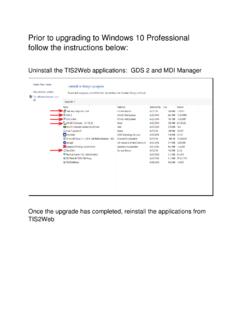Transcription of Upgrading Our Energy System - assets.publishing.service.gov.uk
1 Upgrading Our Energy SystemSmart Systems and Flexibility PlanJuly 20172 Upgrading Our Energy SystemUpgrading Our Energy System 3 ContentsSmart Systems and Flexibility Plan Executive Summary 4 Introduction 5 Guiding principles for a smart, flexible System 7 Towards a smart, more flexible Energy System 10 Removing barriers to smart technologies 11 Smart homes and businesses 14 Markets which work for flexibility 16 Conclusion 20 Summary of Actions 214 Upgrading Our Energy SystemExecutive summaryOur Energy System is changing. There is more low carbon generation, much of it located close to people s homes and businesses, and it produces different amounts of electricity depending on factors like the time of day or the weather.
2 New technologies such as storage are emerging and the costs of many of these technologies are falling rapidly. If we take advantage of the opportunities this provides, we can create new businesses and jobs, empower consumers and help people save up to 40bn1 off their Energy bills in the coming Plan is an important part of the Government s Industrial Strategy, the forthcoming Clean Growth Plan, and a core component of Ofgem s future-facing work to enable the Energy System transition. It is supported by the Government s significant increase in public research and innovation spending, including on new storage technologies. We asked for views on what changes the Government and Ofgem should make through our Call for Evidence last year.
3 We have engaged throughout this process with innovators from across the Energy industry. This Plan shows how the Government and Ofgem are taking action alongside industry to deliver a smarter, more flexible Energy System by: removing barriers to smart technologies, including storage; enabling smart homes and businesses; and making markets work for have heard consistent calls to modernise the regulatory environment for electricity storage. Storage can open up many possibilities, helping to integrate low carbon generation, reduce the costs of operating the System , and help avoid or defer costly reinforcements to the network. But it needs a level playing field to compete. Our plan delivers that through clarity on licensing, planning, connections and charging for storage, and by enabling storage to locate on the same site as renewable generation.
4 This is just one of the new smart technologies that will help to keep bills are empowering consumers by ensuring households and businesses can use Energy when it is cheapest, and reward them for being flexible on when they use Energy . By rolling out smart meters, enabling suppliers to offer smart tariffs, and harnessing the power of data communications in our home appliances and gadgets, we will make it easier for consumers to lower their are also fundamental changes taking place within the Energy markets, which will see new sectors, technologies, and services flourish. Changes that improve access to these markets for smart businesses will enable them to compete fairly and reduce costs for consumers.
5 We want to open up new markets, improve coordination across the System , and enable these businesses to realise the true value of their services. Taken together, these measures will reduce the costs of the Energy System and work to keep Energy bills as low as possible for Our Energy System 5 IntroductionOur Energy System is changing. There is more low carbon generation. There are many more distributed and localised resources. New technologies such as storage are emerging, and the costs of many of these technologies are falling consumers are interacting differently with our Energy System . Close to 1 million homes now have solar panels on their roofs. Smart meters are rolling out, providing the basis for new services to benefit consumers, and smart thermostats are increasingly common.
6 In the future, we are likely to see more electric vehicles and more electrification of are big changes driven by new technology. Information technology can help us minimise the costs of our future low carbon Energy System , whilst ensuring that the System continues to function securely. The Government, and the Energy regulator, Ofgem, want to ensure there is the right framework for these changes to take place. A smart, more flexible Energy future can bring significant benefits for consumers, the System and the wider economy. A study for the Government estimates the benefits of a smart Energy System to be 17-40bn to These benefits come from avoided or deferred network reinforcements, avoided generation build, avoided curtailment of low carbon generation, and better operation of the System .
7 The potential for significant benefits was also reiterated in the Committee on Climate Change s recent annual progress report to study - Home batteries that benefit consumers and the gridBritish company Moixa offers residential battery systems which provide grid support services as an Energy aggregator, in turn delivering cost savings for the consumer. Moixa s Gridshare platform helps the System Operator to manage Energy demands across the electricity network, and the consumer receives extra income in return. The battery can also make better use of Energy generated by solar panels on the consumer s rooftop, and enable suppliers to reward consumers who charge their batteries during periods of low demand, when prices are lower.
8 These systems have been deployed in nearly 1,000 homes across the UK, and Moixa calculate that they could help consumers save up to 60% on their electricity Upgrading Our Energy SystemFor consumers, smart Energy technologies and processes can deliver new services that give people more control over how they use Energy , and help lower bills. For the Energy System , greater flexibility will help deliver reliable power at lower cost. In line with the Government s Industrial Strategy, it will enable new, disruptive technologies and services to compete, and new sectors to flourish, enabling growth across the have already seen early signs of change. This is driven by: an increasing need for greater flexibility across the power System , as we see more low carbon generation deploy and a market-led response with about 3GW of new flexibility contracted since 2016; rapidly falling technology costs, average lithium-ion battery prices have fallen by over 50% since 2012; new IT-enabled business models which are cheaper than traditional engineering solutions, enabling greater aggregation of distributed resources across the System , and active management of distribution networks.
9 And new offers for consumers on home Energy management, smart tariffs, smart appliances and electric harnessing the potential of Energy storage, demand-side response and smarter business models, we have an opportunity to upgrade to one of the most efficient, productive Energy systems in the world. This is central to how we deliver secure, affordable and clean Energy now and in the upgrade of our Energy System is an important part of the Government s Industrial Strategy. Energy is an essential input to all economic activity. Bringing down Energy costs, through the efficient integration of new technologies, can contribute to raising productivity throughout our economy. Further, the transition towards clean and flexible Energy systems is a global trend, presenting a significant industrial opportunity.
10 More than half of all new power capacity installed globally is now renewable, and the global market for electric vehicles grew by 60% in the last year. All countries adopting these new technologies will need systems that integrate them efficiently. The regulatory framework for a smart and flexible System that the Government and Ofgem are putting in place will strengthen market incentives for innovation, and pave the way for UK businesses to take the lead in meeting global demand for the Energy systems of the set out in this Plan, first, the guiding principles of our approach to a smart, flexible System and, second, the specific actions that the Government and Ofgem will undertake or are undertaking Our Energy System 7 Guiding principlesfor a smart, flexible systemAt the centre of our approach is ensuring effective markets and competition.

















